
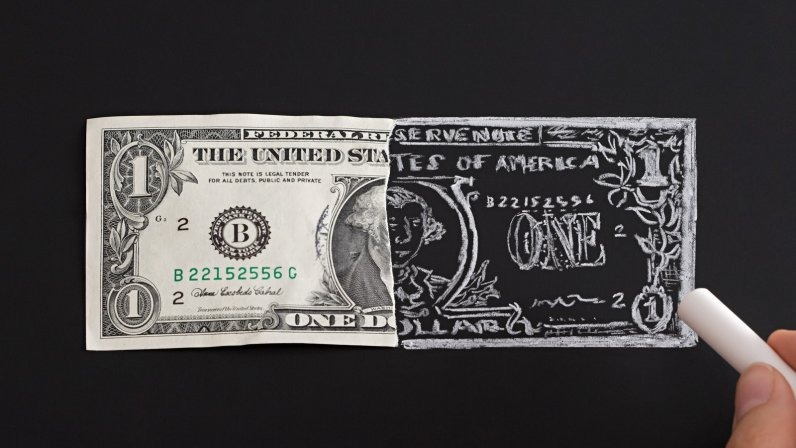
Counterfeiting is one of the most common scams around. Image Source / Getty Images
The allure of Counterfeiting is obvious. If you could do it without getting caught, you would be able to print your own money and buy whatever you want with it. Counterfeiting is the ultimate technology for people who want to get something for nothing.
In the not-too-distant past, Counterfeiting was a difficult and expensive endeavor. It required large printing presses and the ability to cut intricate designs by hand into metal plates. Today, it's much easier to create counterfeit bills. As thousands of teenagers discover every year, if you're willing to break the law, you can create fake money with a PC, a scanner and a color inkjet printer in about 10 minutes.
In this article, we will look at the technology of counterfeiting. You will learn about the techniques that you might use if you wanted to create your own counterfeit bills. We'll also discuss the punishment that you will receive when you get caught trying out these techniques. In the process, you will learn how to detect "funny money" yourself and also discover whether the U.S. money supply is vulnerable to collapse from a sea of counterfeit bills.
Let's say that you would like to start a life of crime by creating your own counterfeit currency. The easiest way to print your own money is to use your PC. If you own a scanner and a printer, it is pretty easy to get started.
The first thing you would do is put a $20 bill on your scanner. Then you would set the scanner for its highest resolution — perhaps 1,200 or 2,400 DPI — and scan an image of the bill. Your scanner would drop a 5 to 10 megabyte file on your hard drive, which you'd print out to use as money.
However, your stint as a counterfeiter wouldn't be very successful. The $20 bill that's been in circulation in the United States since late 2003 is one of the high-tech counterfeit-proof bills from the U.S. Treasury. If you zoom in on different areas of the bill and look at them closely, you can see a number of features designed to deter "casual counterfeiting."
We'll look at the specific features on the face of the bill in the next section.
Contents

The lightly colored lines covering the front and back side of the new $20 bills.
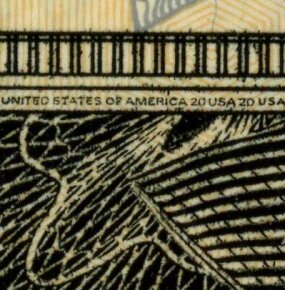
As you can see, the scanner captures all of this with good detail — scanning a $20 bill is no problem.
Find out in the next section why actually printing the bill is, however, a problem.
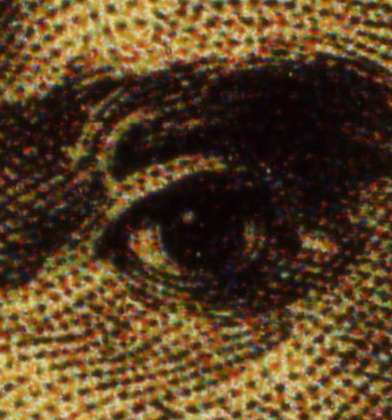
There's an incredible loss of detail when using a low-quality printer.
When you try to print your scanned $20 bill, you discover the problem. The fact that the scanner can capture such detail does not mean that your printer is ready to replicate it. If you try printing on a normal inkjet printer, it comes out looking all wrong to the naked eye. The colors are off and the images look muddy.
You can see why it looks wrong when you put your new counterfeit bill under a microscope. For example, many fine details are completely lost:
And the light-colored hexagons turn to a brighter shade because the printer can't reproduce lines that are fine enough or light enough:
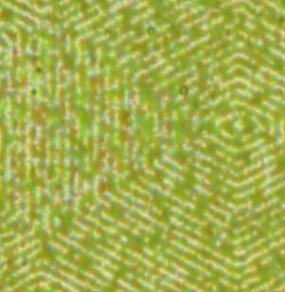
A low-quality printer has trouble printing tiny, lightly colored details.
Compare these two images to their corresponding images from the previous section.
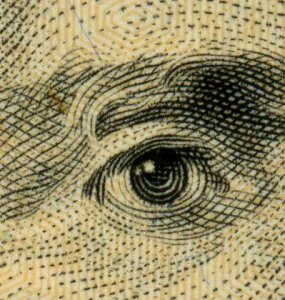
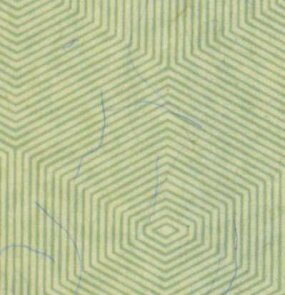
It's obvious that they are not even close. You can actually see what is happening here — the printer cannot replicate the fine lines exactly. In the case of the hexagons, the blobs that the printer ends up producing make the light color of the original bill a much brighter shade. This effect is the very reason for imprinting the lightly-colored hexagons on the bill in the first place — they make the bill harder to replicate with current printer technology.
To some extent, these printer problems can be remedied with a better printer. However, even the best printers lose some of the detail. If a person were to look at the inkjet printer's counterfeit bill with a magnifying glass, it would be obvious that it is a counterfeit. But to the naked eye, a good high-resolution printer can produce a counterfeit bill that looks pretty close to the real thing.
To create an actual bill, you are going to have to test-print your scan a number of times and adjust the color to get the overall tone right. You are also going to have to scan the back of the bill and practice aligning the front and back sides to get a realistic two-sided bill.
If you are careful with your technique and if you have a good enough printer, you will end up with a bill that, although not perfect, looks passably good to the naked eye. It won't have the color-shift ink and it will look a bit muddy in places, but as long as the recipient doesn't look at these details very closely, the illusion will be "good enough" to work.
The easiest way to get around the visual imperfections of your counterfeit bills is to spend the bills in situations where the exact visual details are hard to see. For example, you might try to hand your fake money to a waitperson in a darkened bar or nightclub.
As soon as the person touches the counterfeit money, however, it will be obvious that something is wrong. That's because of the paper.
$1 Million Bill
In 2004, a woman attempted to purchase goods at her local Wal-Mart using a $1 million bill. Of course the U.S. Treasury does not make a $1 million bill, so the funny money was quickly detected. Reportedly, Alice Pike tried to purchase more than $1,600 worth of goods using the counterfeit bill. Perhaps she was planning to visit Target and K-Mart next; Ms. Pike was found to be in possession of two other $1 million notes .
People know what money feels like. People who handle money constantly, like bank tellers, cashiers and waitstaff, can feel a counterfeit bill instantly if the paper is wrong.
That "feel of money" comes from at least three different things that make the paper in paper bills unique:
- Normal paper that you use on a day-to-day basis (newspaper, notebook paper, paper in books, etc.) is made from the cellulose found in trees. Paper used for money, on the other hand, is made from cotton and linen fibers. This kind of paper is known as rag paper. One big advantage of using rag paper is the fact that it does not disintegrate if you accidentally run paper money through a washing machine.
- The paper used for money is thin compared to normal paper.
- The paper used for money is squeezed with thousands of pounds of pressure during the printing process. This makes it even thinner and gives newly made bills a special crispness.
The other special thing about the rag paper used in real money is that there are tiny blue and red fibers mixed into the paper when it is made. These fibers are easy to find in real money, but they are so fine that they do not reproduce very well in the counterfeit money from your inkjet printer.
The last thing a counterfeiter wants to do is print counterfeit money on "normal" printer paper. It will feel all wrong, and it can be detected with a counterfeit pen. These special pens, which often look something like a highlighter, contain iodine that changes color when it comes in contact with cellulose. At the very least, you need to try to find thin rag paper to print on. You can find this kind of paper at most office supply stores.
However, the paper still may not feel right. That's why some counterfeiters go the extra mile to get the perfect paper. The ultimate counterfeit bill would use the same paper used by the government. This paper, however, is nearly impossible to buy.
Yet, if you hunt around the Internet (I used the Google search engine), you can find hundreds of articles similar to an article from The Philadelphia Inquirer. This particular article describes a large-scale counterfeiter named Ricky Scott Nelson who produced and successfully distributed hundreds of thousands of dollars in fake cash. He found a very good source of realistic paper. According to the article:
"Nelson took [actual] $1 and $5 notes and, using tape, masked some of the genuine images such as the Treasury and Federal Reserve Seals, serial numbers, and the "This note is legal tender" advisory. The masked bills were then soaked in bleach to remove the images and denomination numbers ... Nelson then created a template that enabled him to photocopy images and detail from $50 and $100 notes onto the bleached areas of the original currency."
The image from the photocopier, apparently, was "good enough" to pass inspection with the naked eye. The use of real paper got around the feel problem. As a bonus, the bleached bills contained real, unique serial numbers.
But that still leaves a question — what did he do about the color-shifting ink? Surely he did not pass all $800,000 in nightclubs. He would have had to find a source for the special ink, plus a way to print it.

Photo courtesy U.S. Bureau of Engraving and Printing
The newest $20 bills printed by the Treasury contain three special security features that are impossible to fake with an inkjet printer:
- Embedded in the paper, a plastic security strip runs vertically up one side of the note. If President Andrew Jackson is facing you, then the plastic strip is on the left side. Upon close inspection of this security strip, you can see the words "USA TWENTY" and a small flag repeated along the thread. This should be visible on both sides of the bill.
- Located in the bottom right corner on the face of the bill, the number "20" is made of color-shifting ink. A slight backward and forward shift of the bill changes the number "20" from copper to green.
- A faint and smaller version of Jackson's portrait (as seen on the face of the bill) is "hidden" within the paper itself. If you hold the bill up to a light, this watermark is immediately evident from either side of the bill.
How did Nelson get around these features? The article states it this way:
"He used mostly old-style $100 and $50 notes — without the invisible markers implanted in post-1996 series currency — that enabled his cash to fool many people and local retailers."
In other words, Nelson took pre-1996 bills and used them as the models for his reproductions. Most people will still accept the older bills, and since these older bills have none of the fancy features of the newer ones, they are much easier to reproduce.
By putting all of these tricks together, Nelson was able to create fake money that fooled most of the people most of the time — $800,000 is a lot of money.
So, how did he get caught?

When the new $20 bills hit the streets, this educational poster was immediately made available at the The New Color of Money Web site, for use in schools, libraries and many public facilities.Image courtesy U.S. Bureau of Engraving and Printing
Although Nelson did create good reproductions, they could not be perfect reproductions. For example, the ink printed onto real money is not completely absorbed by the paper. This is especially true of the black ink and the color-shifting ink. The ink therefore leaves a texture on the paper that is easy to feel, especially when a bill is new. Your inkjet money will not have this feel, and neither did Nelson's. An easy way around this defect is to crumple up the money so it feels worn.
A more important problem, however, is that some of the inks used by the government are magnetic. Vending machines, for one, are sensitive to these magnetic inks and use them to detect counterfeits. The treasury is also scanning bills regularly to detect counterfeits. According to an article from Wired Magazine, titled "Junior Mints":
"Of the 24.5 billion [bills] scanned and sorted last year, half were $1 bills. They last 18 months in circulation and may be scanned four or five times a year. A $100 bill may be scanned every four years or so; people hold on to them far longer, on average.
Details about how, exactly, these superscanners distinguish good bills from bad are closely guarded. Vending machines, for example, might compare the size of margins on the front and back (looking for telltale out-of-register printing), or scan the portrait, or sense the location of magnetic ink that the bureau uses only in certain parts of the bill. "These machines are much better than that," says Rosanna Pianalto, a policy analyst at Fed headquarters in Washington, D.C. Each machine has 30 kinds of sensors, and some no doubt pick up covert security features."
As the counterfeit bills get used in vending machines and rejected, or as they make their way into banks, where human tellers can feel the difference, or when they get into the hands of an attentive convenience store worker who rejects them, or when they make their way back to the scanning machines at the U.S. Bureau of Engraving and Printing, they are detected. Once they are detected, that alerts authorities to a counterfeiting problem in a certain area of the country. Heightened vigilance, along with news stories and public service announcements, helps to make detection easier. And eventually the counterfeiter gets caught.
With teenagers who are casually counterfeiting, capture is often instantaneous. Teenagers usually make very stupid mistakes when they create counterfeit bills:
- The colors are off
- The paper is wrong
- They print on only one side
- They give the money to classmates who report the crime
Therefore, punishment is swift and sure.
Counterfeiting is not a minor offense. It is not like running a red light, or even shoplifting. These crimes are misdemeanors handled at the local level by local police and courts. Counterfeiting, on the other hand, is a federal felony handled by the U.S. Secret Service. In fact, the entire reason the Secret Service was originally created was to handle counterfeiters. Only later did it take on the role of additionally protecting the president and other key government officials.
The reason why counterfeiting is treated as such a serious crime is because money is so important to our society. Money is the oxygen of the economy. If people cannot trust that the money they carry is authentic, then it gets much harder to buy things and the economy slows down.
When you get caught counterfeiting — and if you are counterfeiting you will get caught eventually — the punishment can be unbelievably harsh. According to this article from Wired Magazine, entitled "Junior Mints":
"Under federal statute 18 USC section 471, if you're found guilty of making copies "in the likeness and similitude of US currency ... unless they are much larger or much smaller than US currency" (a minimum of 50 percent larger or 25 percent smaller) or unless they are "rendered in black and white," you face up to 15 years in the slammer."
If up to 15 years in prison is not enough to deter you, there are additional penalties as well. Authorities will also seize any property used to create or pass the bills. That means your computer, printer and scanner will be confiscated. You will also have to pay restitution and probably a number of fines, too.
In other words, the picture is pretty clear. When you create counterfeit bills, you will get caught. There are a ton of people out there looking for fake bills because they don't want to get ripped off. When you get caught, the penalties will be severe, and it's likely you will end up spending some time in jail. You will have a federal felony arrest on your record, making it very hard to get a job.
In other words, you can't get something for nothing, at least not if you are trying to do it by counterfeiting. Although it is easy to print your own money, it never works when you try spending it.

Whether you are a normal person taking your change at a store, or you are a merchant accepting cash in your business, you need to be aware of the counterfeiting problem. As you have seen, it is easy for teenagers to print counterfeit bills, and there are more sophisticated counterfeiters who are actually bleaching out authentic bills and printing fake bills onto the bleached paper.
Here are several steps you can take to protect yourself:
- Be suspicious; take time to look at and feel the money you receive.
- Check for obvious things like duplicate serial numbers.
- Be especially suspicious of older bills (those bearing old pre-1996 designs) and bills of larger denominations.
- Simply refuse to accept older bills. Nearly all the pre-1996 money that is actually legitimate has been taken out of circulation and destroyed already.
- Look at bills in the light. The color-shift ink is very hard to fake. The security stripe and watermark are impossible to duplicate with an inkjet printer.
- If you believe you are receiving a counterfeit bill, call the police.
A lot of work has gone into creating bills that are hard to counterfeit. If you use the new security features, it is very easy to detect counterfeit bills.

Related Links:
- Counterfeit bill printing machines
- Money printing machine
- Money printing press
- Printing counterfeit money
- Printing fake money
- Printing Movie money
- Buy best bill printing machines amazon
- Buy best bill printing machines ebay
- Buy best bill printing machines alibaba
- 3d printing money
Related Topics:
- https://moneyprintingmachinesforsell.wordpress.com/
- https://wp.me/Pchokq-6
- https://moneyprintersmachines.blogspot.com/2020/08/counterfeit-money-machines.html
- https://moneyprintersmachines.blogspot.com/
- https://moneyprintersmachines.blogspot.com/2020/08/counterfeit-money-machines.html
- http://buymoneyprinters.blogg.org/buy-usd-printing-machine-trusted-and-audited-supplier-a201356496
- https://counterfeitmoneyma.wixsite.com/usdprintingmachines/post/buy-usd-printing-machine

























